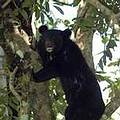 5隻瀕臨絕種的亞洲黑熊的幼熊孤兒被人類當成寵物。這件事情被破獲後5隻黑熊已充公,現在他們已經計劃要被野放。
5隻瀕臨絕種的亞洲黑熊的幼熊孤兒被人類當成寵物。這件事情被破獲後5隻黑熊已充公,現在他們已經計劃要被野放。
這些幼熊被送到位於印度東北方Arunachal Pradesh州的黑熊復育中心,該中心透過野放支援計畫教導幼熊野外生存技能。
這個獨特的計畫是由動物福利國際基金會(International Fund for Animal Welfare, IFAW)及其夥伴組織-印度野生動物基金會和Arunachal Prasesh森林部共同管理。
該中心位於Pakke河畔,四周被熱帶半常綠的森林所包圍,這是印度唯一復育亞洲黑熊並且計劃野放的中心。
IFAW「動物受迫計畫」的執行長A.J. Cady表示:「由於盜獵情況日益嚴重,再加上棲息地的破壞,使得印度的熊已經少見蹤影。這是一個非常特別且重要的計畫,致力保護亞洲的黑熊。我們非常的努力,希望可以變成一個成功的模式,進而推廣到全印度。」
亞洲黑熊(Ursus thibetanus或Seenarctos thibetanus)又稱為西藏黑熊或西瑪拉亞黑熊或月熊。這種中等體型、有尖爪的黑熊,在胸口處有個明顯的白色V字型標誌。
亞洲黑熊名列世界保育組織瀕危物種紅皮書當中。主要面臨的威脅是森林砍伐和棲息地消失,同時很多黑熊是因為農民想要保護自己的牲口而遭到殺害。
黑熊被盜獵的主要原因是取得他的肉或傳統療法所需要的膽汁。亞洲黑熊在Arunachal Pradesh地區常常被原住民部落的獵人被射殺。有時在母熊被射殺後,獵人就會補抓被遺棄的小熊。
以前,原住民通常會撫養這些小熊,但森林部已經禁止這種行為,並開始把幼熊孤兒送到Itanagar動物園,讓他們在那裏渡過餘生。直到2002年黑熊復育中心成立前,印度從未有將黑熊復育並送回野外的案例發生。
Five orphaned endangered Asiatic black bears are being prepared for their return to the wild after having been confiscated from locals who kept them as pets.
The bear cubs were hand raised at the Center for Bear Rehabilitation and Conservation located in northeast India's Arunachal Pradesh state, which directs orphaned bears through an assisted release program.
This unique project is jointly managed by the International Fund for Animal Welfare, IFAW, and its partner organization the Wildlife Trust of India, as well as the Arunachal Pradesh Forest Department.
Situated on the bank of the Pakke River surrounded by tropical, semi-evergreen forests, it is the only project in India that rehabilitates Asiatic black bears and returns them to the wild.
"Bears across India are disappearing due to increased poaching and habitat destruction," said A.J. Cady, director of IFAW's Animals in Crisis and Distress program. "This is a unique and vital program fighting to protect Asia's black bears and we are working very hard to assure its success as a model for all of India," he said.
The Asiatic Black Bear, Ursus thibetanus or Selenarctos thibetanus, is also known as the Tibetan black bear, the Himalayan black bear, or the moon bear. This medium sized, sharp-clawed, black-colored bear has a distinctive white or cream "V" marking on its chest.
The Asiatic Black Bear is listed as Vulnerable on the IUCN-World Conservation Union's Red List of Threatened Species. Threats are deforestation and habitat loss, and the bears also are killed by farmers who want to protect their livestock.
Bears are poached for their meat or bile, which is used to prepare traditional medicines. Asiatic black bears are killed by tribal hunters throughout Arunachal Pradesh and often, when a mother is shot or abandons her cubs, hunters catch the bear cubs.
In the past, tribal members often raised the cubs, until the forest department stopped the practice and began sending orphaned cubs to the Itanagar Zoo to live out their lives. It was not until the establishment of Center for Bear Rehabilitation and Conservation in 2002 that the process of rehabilitating and returning bears to the wild was undertaken in India.
全文及圖片詳見:ENS





